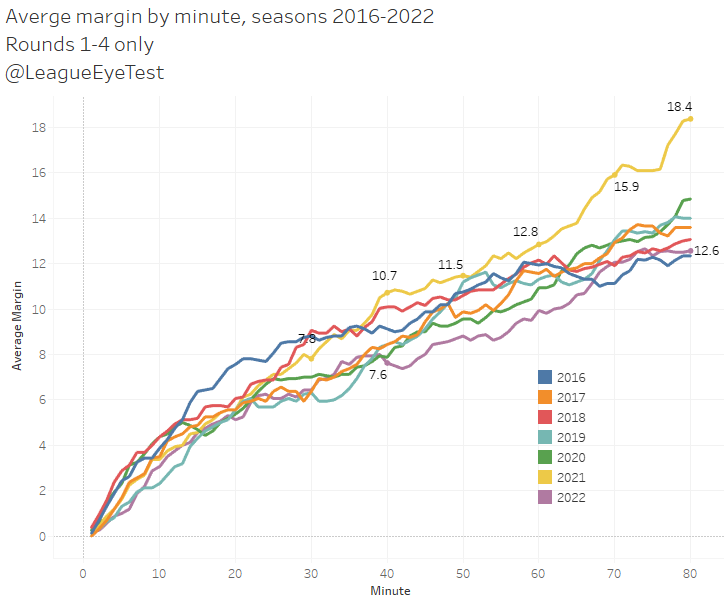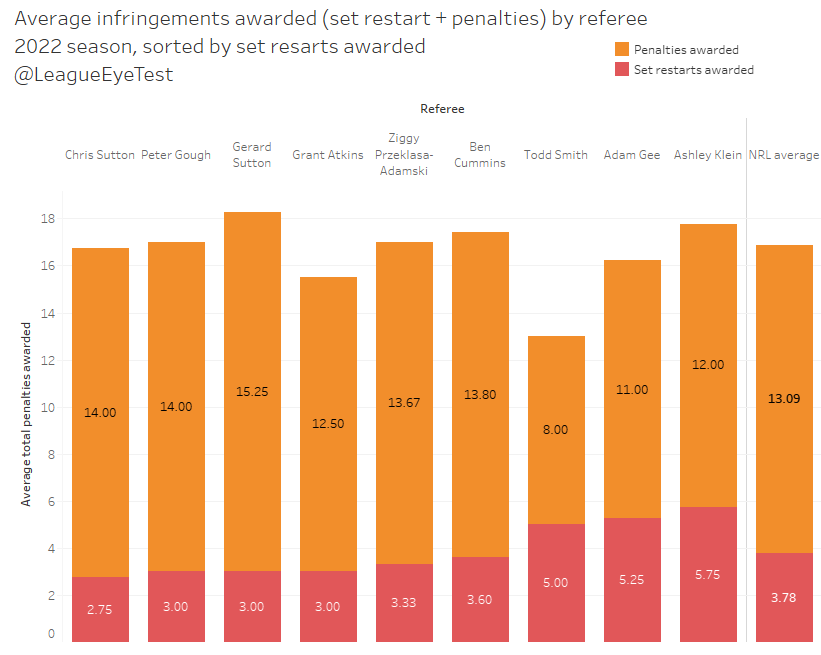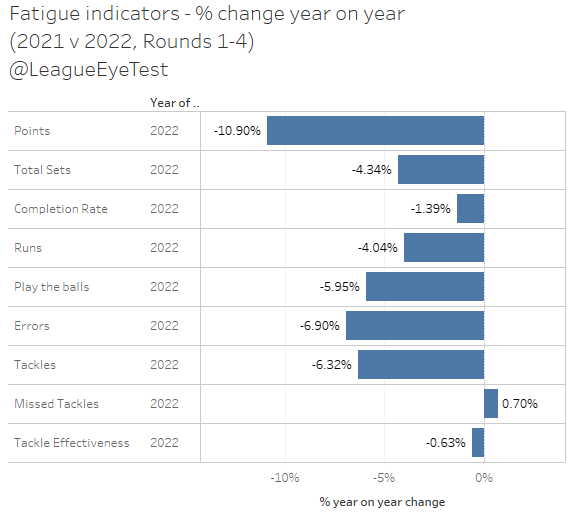We’re only four weeks into the season and Peter V’Landys, much like a toddler endlessly scratching a mosquito bite, he just can’t leave rugby league alone.
And like the other times he’s trying to fix a problem that doesn’t exist.
The product on the field this season has been almost unanimously praised, with one of the lowest average margins in NRL history for 2022 thus far. This praise even came from the head honcho himself a week ago, only to contradict himself this week because a few people got in his ear.
Before I get into the stats about what has exactly changed this season (tl:dr – there’s less “stuff” happening), I wanted to highlight just how competitive this season has been so far and there’s nothing that needs fixing right now. The one thing that did need fixing has at least been partially solved, and we’re seeing fewer blowouts this season which is
In one of my posts last season, I highlighted just how early games were turning into blowouts, which included the chart shown below.
There was an average margin of 11 points by half time and this ballooned to 18.8 at the end of the game meaning the average NRL game in 2021 was decided by more than three converted tries. Games were close for about 25-30 minutes and then the scores exploded as the trailing team became increasingly fatigued.
This season it’s looking much better. Here’s the same chart from above for the first four rounds of seasons 2016-2022, with the purple line representing 2022.

There are some positive conclusions to draw from this chart. The average half time margin has dropped from 10.7 to 7.6 this season, the lowest since 2016. Last season the average margin after 30 minutes was 7.8. The final average margin of 12.6 after 80 minutes is the lowest except for 12.3 in 2016. You can see a tightening of margin right after half time from minutes 40-45 which isn’t something we’ve seen previously.
Additionally, games from the 40th minute to the 68th minute are closer than they’ve been since 2016. If you took out the last two games of round 4, we’d have the closest second half average margin in years, which you can see below.

The average margin for those games would be just 10.8. Again, how is this an issue?
The ridiculous thing is that even though Round 4 is seen as an anomaly because of the two high scoring games that ended the round, for 60% of the game it was right on average with prior years and the margins only significantly jumped past 60 minutes as you can see below.

Need more proof?
For the first four rounds in 2021, nearly 30% of all game time was played with a margin of at least 13 points, with just one third of game time played with a margin between 1-6 points. Let’s see how that has changed for 2022.

20% of game time is spent tied. Less than 20% of minutes are being played with a margin more than 13 points, and 60% of game time is passing with a margin of less than 6 points. Last season the latter number was 49%. The 40% of time spent between 1-6 points is also the highest since 2016 when it was 40.7%.
The games have never been closer and for a product that is so largely driven by television revenue this is exactly what they should be striving for – a product people don’t want to turn off.
Even if the rules aren’t exactly where we’d like them to be (I’m firmly in the no set restarts, two referees – one for the ruck and one policing 10 metres camp), we’ve obviously hit a sweet spot for competitive matches even where there’s a talent disparity. It won’t always be the case as the end of Round 4 showed, but they’re happening more frequently now.
Again, the value of the game as a whole is worth more than the sum of its’ parts. Wrestling in the ruck has existed for decades and always will as coaches find a way to slow play down.
The “wrestle” didn’t stop the Eels scoring some amazing tries on the weekend. And as diabolical as most of the Gold Coast v Wests Tigers game was, the end of the game was thrilling due to the close score line. Anyone who watched that game may not want to remember it, but they’ll never forget the ending.
Yet somehow this needs fixing (again)?
Maybe for someone who only follows the game by highlights and dinosaur media talking head panel shows. But the consensus seems to be that the start of this season has reignited the love of rugby league for a lot of fans.
Especially this one.
The “wrestling” agenda
There’s been no shortage of articles about the speed of the game or the “wrestle” sneaking back in with the change of rules this season. The cynic in me partly believes that the increase in articles citing “wrestling” as an issue in the game (it isn’t) is just a SEO ploy to piggyback on the WWE running two nights of Wrestlemania over the weekend.
I’ve got Manly many Gould good ideas as to who were the people were that “leaked” this information that claims to prove the wrestle is back, and are helping set PVL’s agenda, but that’s not really relevant. Coaches will complain about anything, especially the ones struggling to adapt to whatever rule is being “enforced” this round.
There’s also the completely disingenuous part of “leaking” total numbers from three rounds. If you want to see what has changed, you should also be looking at the rate of things occurring and not just the totals, something I’ve written about before on another subject. There’s less time in play so of course the total of “stuff” happening will be lower. Obvious agenda is obvious.
Even taking it at face value, the specific point in one of the Sydney Morning Herald stories around there being 28 more offloads in 2021 accounts sounds big but is insignificant. It’s just one less offload per game this season. And by the Fox Sports data I’m looking at, there’s actually now been more offloads per game in 2022 than in 2021 after four rounds – 19.1 last year and 19.2 this year. And when you account for there being fewer runs (down 4%), the fact there’s been more offloads indicates teams are actually trying to offload more.
Another classic case of the perils in using small sample sizes and jumping in too early. Again, the agenda couldn’t be more transparent.
What is happening is a winding back of the statistical inflation that 2021, and to a lesser extent 2020, introduced to the game. Ben Quagliata posted an excellent article on this whole subject yesterday which is well worth reading. He noted that one of the biggest downsides of this statistical inflation is that it creates unrealistic comparisons for the games greatest players.
With the reversion to the mean we’re seeing this season, suddenly the greats don’t seem as “great” anymore because of the ridiculous things we saw last season. That doesn’t make them any less great.
If you’re going to argue that the games best players aren’t having as much impact, it’s hard to argue a case for that on a weekend when we saw Ryan Papenhuyzen score four tries and Mitch Moses architect a huge victory for the Eels.
Coaches will adapt in time, and those that don’t shouldn’t be coaching first grade anyway, something I touched on last week.
We’ve already debunked the offload narrative. Let’s delve what has changed to put some of these other myths to bed.
Time in play

As you’d expect with the change to a penalty inside 40 metres, time in play has decreased on the past two seasons but is up on 2019 (the last year of the rugby league that we all know and love. The drop would be larger but the increased number of penalties – which I’ll get to shortly – is offset by the reduction in tries and time spent watching players take conversions. Round 4 saw the most time in play this season with an average of 55.5 minutes per game.
Set restarts and penalties
Looking at set restarts and penalties awarded per game, the former is down, and the latter has increased, again as you’d expect with the rule changes.

Set restarts have dropped from 7.1 to 3.8 per game (down 3.3 per contest) whilst penalties are up from 6.4 over the first four rounds last season to 13.1 this season. That’s an increase in infractions of 5.6 extra penalties per game, which would account for some of the decline in time as discussed above.
Another trend worth noting is that we’re seeing the lowest number of play the balls per infringement this season.

There’s was a set restart or penalty blown ever 15.6 play the balls in Round 4, down from over 20 per infringement last season over the same period. Yet somehow this isn’t enough of a crackdown and we’re going to see more of them this weekend?
On the referees side, there’s two referees still awarding set restarts like its 2021 and it’s exaclty who you’d think it is (Todd Smith gets a pass as he’s only called one game).

Fatigue indicators
Last season I started looking at some fatigue indicators. These were just basic stats that I felt were reflected fatigue as they usually involved some decision making or how often things were happening. Unsurprisingly with more ball in play and fewer stoppages last season pretty much everything increased.
This season, almost everything is down as you can see below.

Total points are down 11% and total sets and runs are down 4%, with play the balls being down nearly 6%. Given this you’d expect to see a 4-6% decline in most statistical categories this season as there is less opportunity to do more “stuff” in the game.
It is interesting then to see that the number of errors per game is over indexing, declining at 7%, which indicates either teams aren’t as fatigued from endless defending and not making mistakes they would have last season, or teams are playing a more conservative style. It’s probably a mix of both, as completion rates are only down 1.4%.
The one thing that is up is missed tackles, which are up 0.7% leading to a 0.6% drop in tackle effectiveness.
In conclusion, teams have the ball less, are running less but are missing slightly more tackles. Line breaks are down by 10% though, which indicates that teams aren’t gassed and when someone does miss an assignment it’s not causing a catastrophic collapse of their defensive line.
The game doesn’t need fixing, it just needs to understand that just because someone has an agenda they don’t need to have it resolved.
If you enjoyed this post please consider supporting The Rugby League Eye Test through one of the links below.
[crypto-donation-box type="tabular"]



